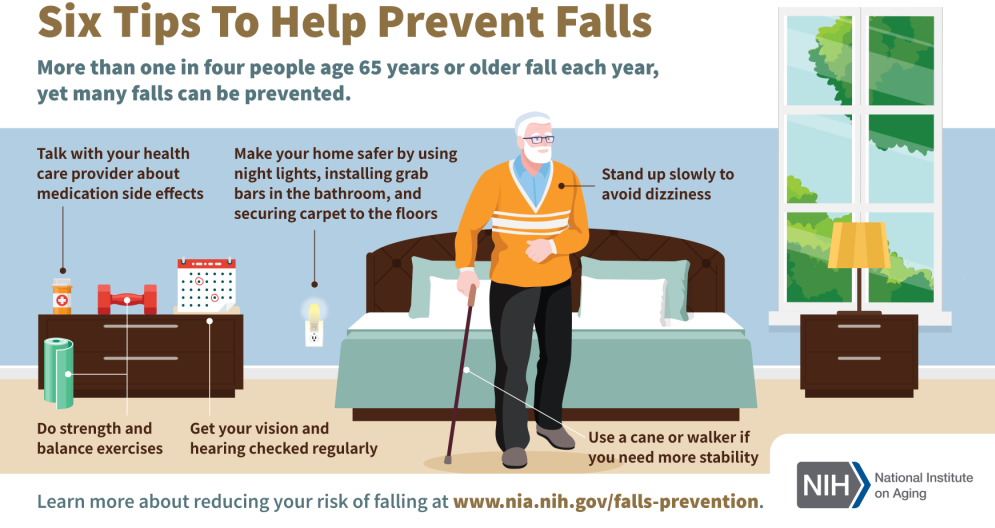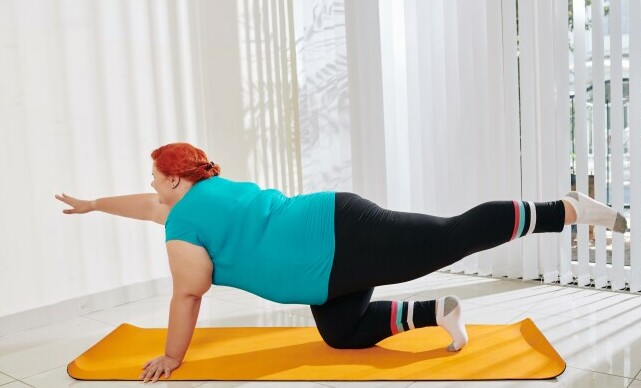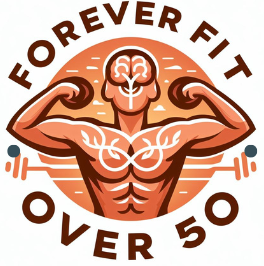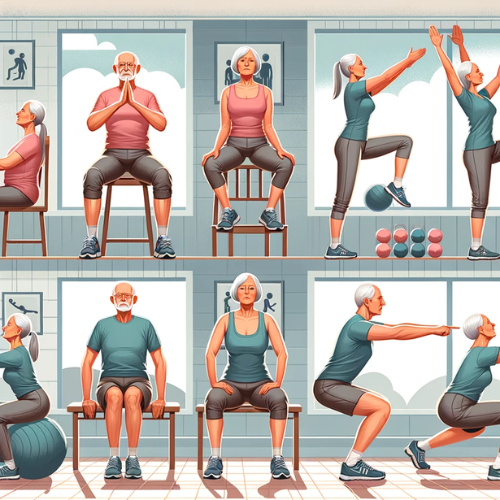Building on my previous post “Balance and Stability Exercises For Over 50s,” I’ll focus significantly on the critical issue of falls and fractures, which pose a serious risk for seniors. Some exercises in this post are repeated from the above mentioned post to highlight their importance. As our bodies age, we experience a range of physical changes that can impact our balance and stability. One of the most significant concerns for older adults is the heightened risk of falls. These incidents can lead to severe injuries, a loss of independence, and even life-threatening complications. I hope to provide a clear understanding of why fall prevention is a vital issue.
The statistics tell a sobering story: according to the Centers for Disease Control and Prevention (CDC), millions of people aged 65 and older fall each year, with one out of five falls causing a serious injury such as broken bones or a head injury. It’s not just the physical consequences; the psychological impact of falling can lead to a fear of falling again, curtailing daily activities and reducing quality of life.
It’s not all grim, though. There’s strong evidence to suggest that exercise can be a powerful tool in reducing the risk of falls. By enhancing strength, improving balance, and increasing flexibility, tailored fall prevention exercises can help older adults maintain their independence and confidence. I will delve into practical ways to incorporate these exercises into a daily routine with safety and personal fitness levels in mind.
Assessing Fall Risk and Getting Started
Falls don’t occur out of the blue; they’re often the culmination of various risk factors. Understanding these can be the first step toward prevention. In older adults, risk factors include muscle weakness, balance issues, and medications that might affect steadiness. Environmental hazards like poor lighting and loose rugs also contribute.
Assessing one’s risk for falls starts with a frank conversation with a healthcare provider. They can evaluate risk factors, medication impact, and advise on a fall prevention strategy. This conversation is crucial as it tailors the prevention plan to individual health conditions and lifestyle.
It’s important to prepare a safe space for exercising. This might mean clearing an area of clutter, ensuring good lighting, or investing in non-slip mats. Family members can assist in this preparation, making the environment as conducive to safety as possible.
Before diving into an exercise regimen for fall prevention, getting clearance from a health professional is advisable. They can recommend specific exercises that align with one’s health status and fall risk. Starting slowly, with guidance, can lead to building a more effective and safe workout routine over time.
To Assess Fall Risk, Let’s Look at What Causes Falls in Older Adults?
From The National Institute On Aging: Many things can cause a fall:
- Your eyesight, hearing, and reflexes might not be as sharp as they were when you were younger.
- Certain conditions, such as diabetes, heart disease, or problems with your thyroid, nerves, feet, or blood vessels can affect your balance and lead to a fall.
- Conditions that cause rushed movement to the bathroom, such as incontinence, may also increase the chance of falling.
- Older adults with mild cognitive impairment or certain types of dementia are at higher risk of falling.
- Age-related loss of muscle mass (known as sarcopenia), problems with balance and gait, and blood pressure that drops too much when you get up from lying down or sitting (called postural hypotension) are all risk factors for falling.
- Foot problems that cause pain, and unsafe footwear such as backless shoes or high heels, can also increase your risk of falling.
- Some medications can increase a person’s risk of falling because they cause side effects such as dizziness or confusion. The more medications you take, the more likely you are to fall.
- Safety hazards in the home or community environment can also cause falls.

Core Strength and Stability Exercises
Older adults can reap considerable benefits from enhancing core strength and stability, which can be pivotal in preventing falls. A robust core stabilizes your entire body, improving your balance and providing a solid foundation for all movements. Your core isn’t just about your abdominal muscles; it includes muscles throughout your trunk, pelvis, and back.
One effective way to boost core stability is through seated leg lifts. This exercise is perfect if you’re concerned about balance during your workouts. Start by sitting in a chair with your back straight, feet flat on the floor, and arms at your sides. Lift one leg at a time, hold it in the air for a few seconds, then lower it back down gently. Aim for multiple repetitions with each leg.
Another recommended exercise is the pelvic tilt, which strengthens the lower back and abdominal muscles. Lie on your back with your knees bent and feet flat on the floor. Tighten your abdominal muscles and push your lower back into the floor. Hold this position for a few seconds, then relax. Repeat several times, increasing the hold duration and repetitions as you progress.
Balance-based workouts are as crucial as strengthening exercises. The classic standing on one foot is a simple yet effective balance exercise. Hold onto a chair for support and lift one foot slightly off the ground. As your balance improves, try to rely less on support until you can hold the position without any aid. The industry standard is to aim for at least 30 seconds on each foot.
The heel-to-toe walk sharpens your balance and coordination, critical factors in preventing missteps and falls. Place the heel of one foot just in front of the toes of the other foot each time you take a step. If you need to, steady yourself with a wall or countertop along the way. This exercise mimics the natural motion of walking, increasing both confidence and capability in everyday activities. Check out this YouTube link for further details regarding the heel-to-toe walk.
It’s essential to practice these exercises consistently, but also to listen to your body and avoid pushing yourself too hard, too fast. Over time, you’ll likely notice not only improved stability but also an overall enhancement in your ability to perform day-to-day activities with greater ease and less fear of falling.
Check out this YouTube link for Top 10 easy at home exercises to increase your Balance; Sit to Stand; Heel to Toe Stand; Side Stepping; Single Leg Stands; Pillow Tap; Backwards Walking; Sit to Stand – Arms Crossed; Heel to Toe Forward & Backward; Stepping Over a Pillow; One Leg Stands. Before you embark on any of these programs Please Consult your Doctor. These exercises are progressive so they will get a little harder as you progress. So Pleas start slow and only do what you’re comfortable in doing. If you do this daily for a month you will see a definite improvement in your balance.

Flexibility and Mobility Training
If you’re reading this, you know that maintaining physical flexibility is vital for reducing fall risks. It’s about allowing your body the range of motion it needs to perform daily activities safely and with ease. As joints and muscles tend to stiffen with age, committing to regular flexibility and mobility exercises is a smart move for any older adult.
Now, stretching exercises aren’t just about touching your toes or reaching for the sky. They should target various muscles and joints to improve overall mobility. Think about movements that involve the shoulders, neck, hips, and ankles. Simple routines such as arm circles, neck tilts, hip rotations, and ankle rolls can make quite a difference.
The golden rule here is to stretch gently and hold each position for about 15 to 30 seconds. This slow and controlled approach helps prevent injuries and allows muscles to elongate properly. Incorporating stretching exercises into your daily regimen, even outside of your formal workout times, can contribute substantially to your flexibility.
Moreover, don’t underestimate the power of activities such as Tai Chi or yoga. These practices can significantly enhance your joint mobility, which is crucial for movements that involve balance and coordination. Plus, they come with the added bonus of providing a sense of calm and mental clarity.
So, how do you keep up with flexibility and mobility exercises? It’s about weaving them into your life until they become second nature. Start with a few minutes each day, and as your body adapts, gently increase the duration and variety of stretches.
Building a Sustainable Fall Prevention Routine
Staying consistent with fall prevention exercises is the key to lasting benefits and reduced risk of falls. A personalized exercise schedule that fits your lifestyle and preferences makes it easier to stick to the routine. Remember, regularity is essential; even short daily sessions can lead to significant improvements over time.
These exercises should evolve into habits, seamlessly integrating into your everyday life. For example, practicing balance while brushing teeth or doing leg lifts while watching TV are small steps that add up. As your strength and balance improve, updating or adding new exercises ensures continued progress.
A powerful motivator for adherence is a support system. This could be a group class, a friend who shares your dedication to fitness, or a family member who encourages your efforts. Community programs are also an invaluable resource; they offer guidance and a sense of camaraderie with others who share similar goals.
Lastly, I emphasize the necessity of patience and persistence. Results take time, but with a careful approach and unwavering commitment, you can significantly enhance your quality of life by minimizing the risk of falls. Keep moving, stay cautious, and cherish your independence with each step you take toward a safer, healthier you.
If you haven’t already don’t forget to Check out Neuro-Balance’s proven System:
Here’s a little transparency: Our website contains affiliate links. This means if you click and make a purchase, we may receive a small commission. Don’t worry, there’s no extra cost to you. It’s a simple way you can support our mission to bring you quality content.


As an over 50 adult myself, I know firsthand about this subject. I have not yet fallen and hope I don’t, however I have gotten dizzy spells a few times. Likely that was from my blood pressure. I think the most important thing to do as we age is to drink plenty of water, eat healthy and exercise daily. My favorite exercises are mostly stretching and sit ups and push ups. These can be done anywhere with no equipment. I also like to lift weights, but have a hard time staying on task with that.
Hi Robin,
Thank you so much for sharing your personal experience and insights with us. It’s wonderful to hear from someone who is proactive about their health and wellness, especially as it pertains to navigating the challenges that can come with aging. You’re absolutely right about the importance of hydration, a balanced diet, and regular exercise. Your go-to exercises like stretching, sit-ups, and push-ups are fantastic choices for maintaining strength and flexibility, and they indeed offer the convenience of being performed anywhere without the need for equipment.
Dizziness can indeed be concerning, and it’s wise to be mindful of factors like blood pressure that could contribute to it. Incorporating balance and strength exercises, as you’re already doing with your routine, is definitely a step in the right direction. As for lifting weights, it’s a common challenge to stay consistent, but perhaps incorporating it into a routine with exercises you already enjoy could help. Even light weights can make a significant difference over time.
Keep up the great work with your health and fitness journey. Your approach is inspiring, and your caution regarding dizziness is a reminder for all of us to listen to our bodies and seek medical advice when needed. Thank you for being part of our community and for contributing to the conversation with your valuable perspective. Stay strong and keep moving forward!
Regards,
Gary
hi robin, thanks for sharing your experience, absolutely staying fit and healthy over 50 is crucial for maintaining overall well-being and quality of life. it was fantastic topic truly there is no age number to stay fit, I will remember your topic. I will remember, fitness over 50 is a journey, not a destination. It’s about making choices that enhance your life in the long run. So, let the rhythm of hydration, the melody of nutrition, and the harmony of exercise guide you towards a healthier, more vibrant you.
Hello Zain,
Thank you so much for your thoughtful response. I’m truly glad to hear that you found the topic on staying fit and healthy over 50 so resonant. Your perspective adds a beautiful layer to the conversation, reminding us all that fitness is indeed a timeless journey, not a mere destination.
I love how you’ve framed it – letting the “rhythm of hydration, the melody of nutrition, and the harmony of exercise” guide us. This poetic encapsulation of a holistic approach to health is both inspiring and motivating. It’s a reminder that every step we take towards our well-being, no matter how small, contributes to a richer, more vibrant life experience.
Your comment reinforces the idea that making conscious choices about our health can have profound long-term benefits. It’s encouraging to see this shared understanding and commitment to wellness, and I’m thrilled to know that the message resonated with you.
Let’s all continue to support each other on this journey, celebrating our progress and learning from our experiences. Here’s to a healthier, more vibrant us, at every age!
Warm regards,
Gary